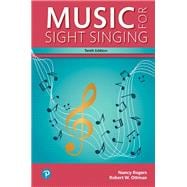For courses in sight singing and music theory.
The most celebrated, engaging, and musical sight-singing text on the market
A freshly updated edition of the classic musical textbook, Music for Sight Singing, 10th Edition, is structured around organized melodies, drawn from the literature of composed music and a wide range of the world’s folk music. Real music exercises allow readers to practice sight singing and develop their “mind’s ear,” the ability to imagine how music sounds without first playing it on an instrument. The new edition includes even more melodies and several new topics; improved introductions to minor keys, pre-dominant leaps, and chromaticism; and increased use of bass and C clefs — while retaining the simple-to-complex arrangement that lays the foundation for success.
Nancy Rogers is an Associate Professor of Music Theory at Florida State University. With research interests including music cognition and its pedagogical implications, Dr. Rogers has presented papers at national and international conferences, including meetings of the Society for Music Theory, the Society for Music Perception and Cognition, the International Conference on Music Perception and Cognition, and the Conference on Interdisciplinary Musicology. She was a keynote speaker at the 2009 Musical Ear conference held at Indiana University. Several of her recent publications may be found in Music Theory Online, the Journal of Music Theory Pedagogy, and Em Pauta.
Professor Rogers received her PhD in music theory from the Eastman School of Music; she is also a Mellon Fellow in the Humanities. She has served as President of Music Theory Southeast, Secretary of the Society for Music Theory, and Treasurer of Music Theory Midwest. Before coming to Florida State University, she served on the faculties of Northwestern University, the University of Iowa, and Lawrence University.
PART I.
MELODY: DIATONIC INTERVALS
RHYTHM: DIVISION OF THE BEAT
1. RHYTHM: Simple Meters; The Beat and Its Division into Two Parts
2. MELODY: Stepwise Melodies, Major Keys
RHYTHM: Simple Meters; The Beat and Its Division into Two Parts
3. MELODY: Leaps within the Tonic Triad, Major Keys
RHYTHM: Simple Meters
4. MELODY: Leaps within the Tonic Triad, Major Keys
RHYTHM: Compound Meters; The Beat and Its Division into Three Parts
5. MELODY: Minor Keys; Leaps within the Tonic Triad
RHYTHM: Simple and Compound Meters
6. MELODY: Leaps within the Dominant Triad (V); Major and Minor Keys
RHYTHM: Simple and Compound Meters
7. THE C CLEFS Alto and Tenor Clefs
8. MELODY: Further Use of Diatonic Leaps
RHYTHM: Simple and Compound Meters
9. MELODY: Leaps within the Dominant Seventh Chord (V7); Other Diatonic Seventh Leaps
RHYTHM: Simple and Compound Meters
PART II.
MELODY: DIATONIC INTERVALS
RHYTHM: SUBDIVISION OF THE BEAT
10. RHYTHM The Subdivision of the Beat: The Simple Beat into Four Parts, The Compound Beat into Six Parts
11. MELODY: Leaps within the Tonic and Dominant Triads
RHYTHM: Subdivision in Simple and Compound Meters
12. MELODY: Further Use of Diatonic Leaps
RHYTHM: Subdivision in Simple and Compound Meters
PART III.
MELODY: CHROMATICISM
RHYTHM: FURTHER RHYTHMIC PRACTICES
13. RHYTHM and Syncopation Melody
14. RHYTHM and Triplet Division of Undotted Note Values;
MELODY: Duplet Division of Dotted Note Values
15. MELODY: Chromaticism (I): Chromatic Embellishing Tones; Tonicizing the Dominant; Modulation to the Key of the Dominant or the Relative Major
16. MELODY: Chromaticism (II): Tonicization of Any Diatonic Triad; Modulation to Any Closely Related Key
17. RHYTHM and Changing Meter Signatures; The Hemiola;
MELODY: Less Common Meter Signatures
18. RHYTHM and Further Subdivision of the Beat;
MELODY: Notation in Slow Tempi
19. MELODY Chromaticism (III): Additional Uses of Chromatic Tones; Remote Modulation
PART IV. THE DIATONIC MODES AND RECENT MUSIC
20. MELODY The Diatonic Modes
21. RHYTHM and The Twentieth and Twenty-First Centuries
MELODY
APPENDIX A: RHYTHM SOLMIZATION
APPENDIX B: PITCH SOLMIZATION
APPENDIX C: MUSICAL TERMS

